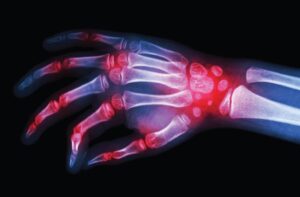 EULAR 2022 (VIRTUAL)—It is reassuring for patients and physicians when the presentation and treatment of a disease follow the course outlined in medical textbooks. However, the real world is often much more complicated than an idealized scenario, and clinicians must think critically and creatively about how to care for patients with difficult-to-manage disease.
EULAR 2022 (VIRTUAL)—It is reassuring for patients and physicians when the presentation and treatment of a disease follow the course outlined in medical textbooks. However, the real world is often much more complicated than an idealized scenario, and clinicians must think critically and creatively about how to care for patients with difficult-to-manage disease.
At the 2022 Congress of the European Alliance of Associations for Rheumatology (EULAR), Jacob M. van Laar, MD, PhD, professor of rheumatology, University Medical Center Utrecht, the Netherlands, provided an instructive lecture on the subject of difficult-to-treat rheumatoid arthritis (RA).
Challenging Conditions
Dr. van Laar began his presentation with a discussion of patient characteristics that may make efficacious treatment of RA challenging. Certain medical comorbidities may cause disease-modifying antirheumatic drugs (DMARDs) to be less effective and may increase the risk of adverse drug reactions. Also, medical comorbidities could hamper a clinician’s ability to properly grade RA disease activity, leading to inappropriate treatment decisions.
Examples: Data indicate fibromyalgia can be common in patients with severe RA.1 Obesity can decrease the effectiveness of treatments, worsen subjective measures of disease activity, reduce the likelihood of achieving remission in early disease, reduce the probability of sustained remission and worsen long-term outcomes in RA.
In addition to medical comorbidities, Dr. van Laar described work that has demonstrated a pauci-immune pathotype that can often be seen when synovial biopsies are performed in patients with difficult-to-treat RA. In these patients, the synovitis seems to be driven by stromal cell pathology, and these cells are not affected by the conventional drugs used to treat RA.
What Is Difficult-to-Treat RA?
Before proceeding with his talk, Dr. van Laar helped provide a clear definition of what may constitute difficult-to-treat RA. He noted that patients in this category should have failed to respond to at least two biologic or targeted synthetic DMARDs with different mechanisms of action after having already failed to respond to conventional synthetic DMARDs. Patients with difficult-to-treat RA may also have signs suggestive of active or progressive disease, namely one or more of the following: at least moderate disease activity, as measured by the Clinical Disease Activity Score or other tools; active synovitis on exam; elevated inflammatory markers or new erosive disease on imaging; the inability to taper glucocorticoids to <7.5 mg of prednisone per day; and/or reduction in quality of life. Finally, the management of symptoms should be perceived by patients and/or rheumatologists as problematic.
Using this definition of difficult-to-treat RA, 5–20% of all patients with RA may fit into this category.2
Contributing Factors
Dr. van Laar discussed work that he and colleagues undertook to better understand the contributing factors and burden of disease seen in patients with difficultto-treat RA. In this prospective study, 52 patients with RA were classified as having difficult-to-treat disease and compared with 100 patients with RA who did not meet this definition.3 The authors identified lower socioeconomic status at the onset of RA as an independent risk factor for the development of difficult-to-treat disease.
Other factors that were independently associated with difficult-to-treat disease include limited drug options as a result of adverse events from therapy, mismatch between doctor and patient in the wish to intensify treatment, fibromyalgia and poorer coping skills. A higher prevalence of alcohol use, anxiety and depression was seen in patients with difficult-to-treat disease, compared with controls.
In evaluating the financial aspects of care, patients with difficult-to-treat RA generated about double the healthcare costs of patients without difficult-to-treat disease. The main driver of costs is not just medications, but also the time that family members, friends and relatives invest in caring for these patients. This leads to lost work productivity and collateral costs to these individuals and to society.
In evaluating the financial aspects of care, patients with difficult-to-treat RA generated about double the healthcare costs of those patients without difficult-to-treat disease.
Workflow
A workflow can be used in approaching patients with difficult-to-treat RA. If a patient with RA is showing persistent signs and symptoms of disease activity despite treatment, Dr. van Laar noted the clinician’s first step should be to see if the patient meets the EULAR definition of difficult-to-treat disease. The rheumatologist should then assess for comorbidities that can mimic the signs and symptoms of active disease or may interfere with arthritis assessment.
The rheumatologist should also evaluate whether arthritis activity is present, and in some cases where such an assessment is equivocal, use of ultrasound may be indicated. It is also important, in a professional and nonjudgmental way, to speak with the patient and see if medication nonadherence is at play. Once all of these issues have been evaluated and addressed, then changes to pharmacologic treatment can be made while simultaneously increasing focus on nonpharmacological treatments, which include patient education, increased physical exercise and self-management strategies that can help with coping with disease.
Research Agenda
Many questions remain with respect to the research agenda and what is on the horizon for this theme. Potential research questions include: How can clinicians optimally confirm the RA diagnosis in patients with difficult-to-treat disease? What is the role of synovial biopsies in assessing the presence or absence of inflammation in difficult-to-treat disease? Which biologic and targeted synthetic DMARDs may be most effective in treating the majority of these patients? Could the development of the difficult-to-treat state be prevented by adequate management of contributing factors early in the course of disease? How do common issues, such as obesity and smoking, impact these patients long term?
Dr. van Laar explained that because the definition of difficult-to-treat disease has only recently been formalized, much is still to be learned about patients who fit this category. In addition, it is important that research studies use case definitions appropriately so the results may be generalizable to similar patients in the real world.
In Sum
At the end of the lecture, Dr. van Laar stressed the traits, comorbidities and elements of care associated with difficult-totreat disease are varied and multifactorial, thus a holistic approach to care is important. It is essential to remember that difficult-to-treat disease is not end-stage or irreversible and that creativity, collaboration and good communication with patients are key to helping patients meet their goals.
Jason Liebowitz, MD, completed his fellowship in rheumatology at Johns Hopkins University, Baltimore, where he also earned his medical degree. He is currently in practice with Skylands Medical Group, N.J.
References
- Pollard LC, Kingsley GH, Choy EH, Scott DL. Fibromyalgic rheumatoid arthritis and disease assessment. Rheumatology (Oxford). 2010 May;49(5):924–928.
- Nagy G, Roodenrijs NMT, Welsing PM, et al. EULAR definition of difficult-to-treat rheumatoid arthritis. Ann Rheum Dis. 2021 Jan;80(1):31–35.
- Roodenrijs NMT, van der Goes MC, Welsing PMJ, et al. Difficult-to-treat rheumatoid arthritis: Contributing factors and burden of disease. Rheumatology (Oxford). 2021 Aug 2;60(8):3778–3788.

